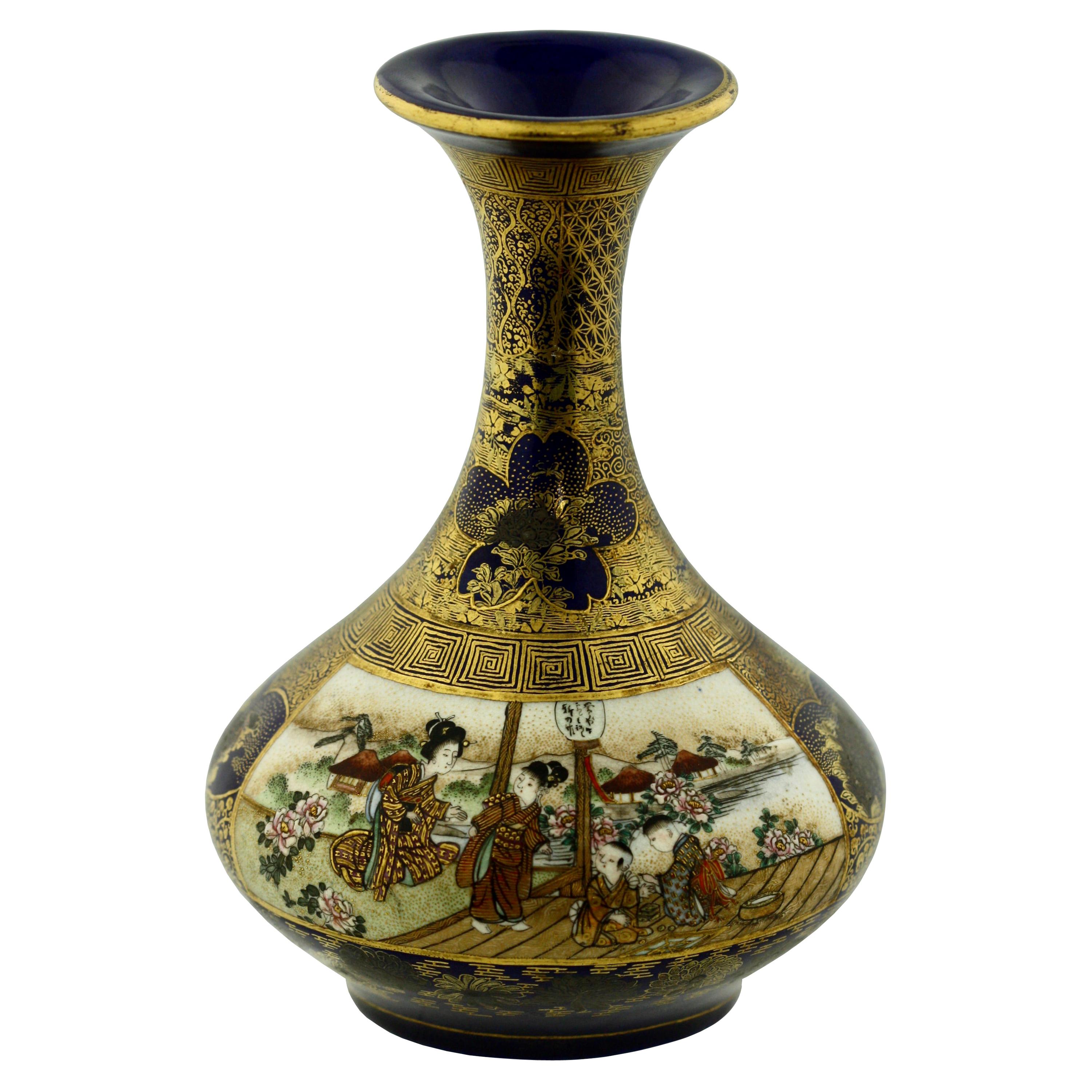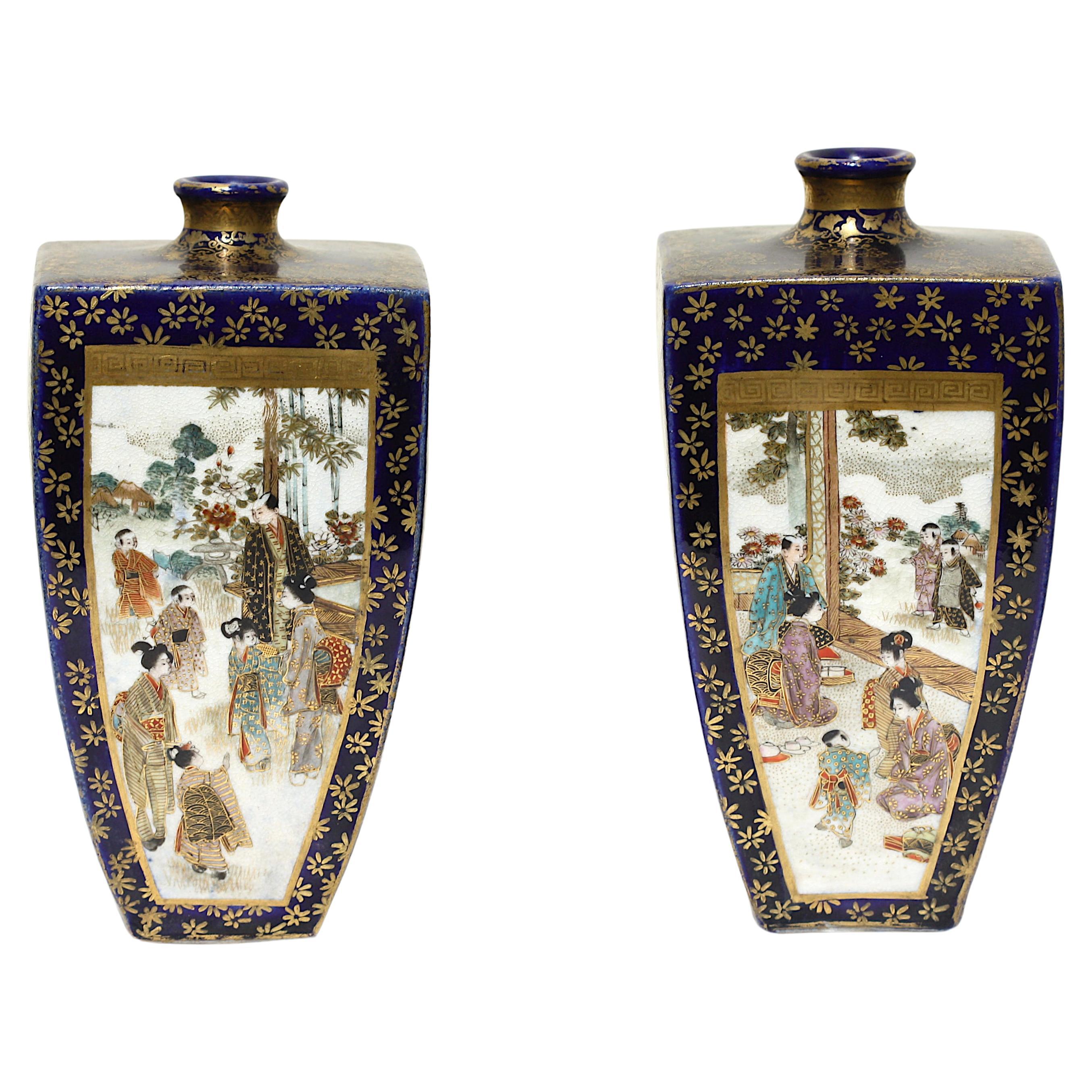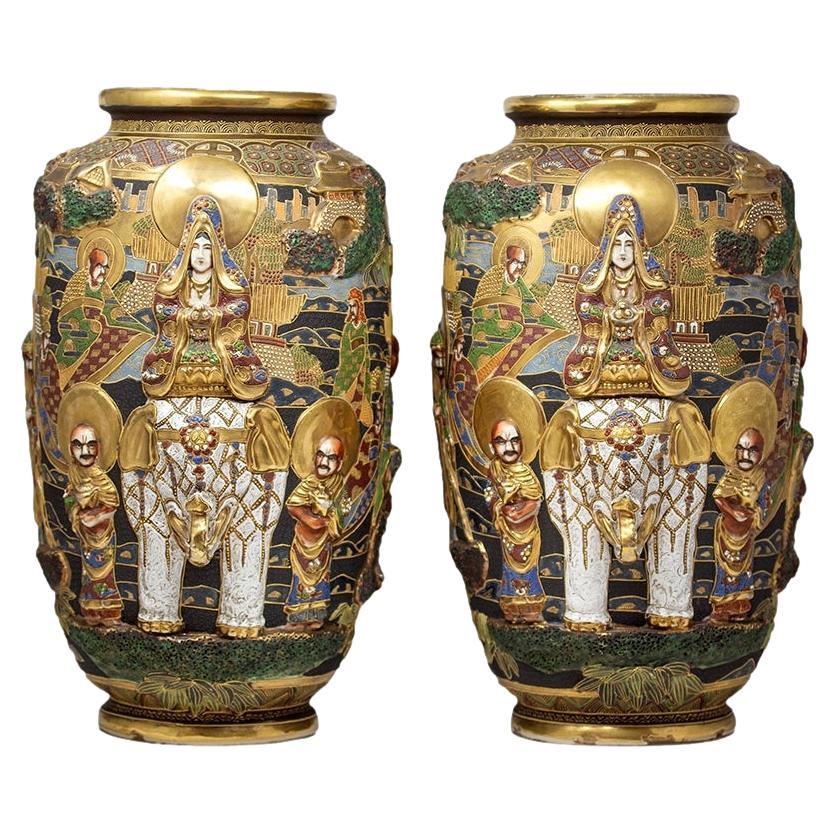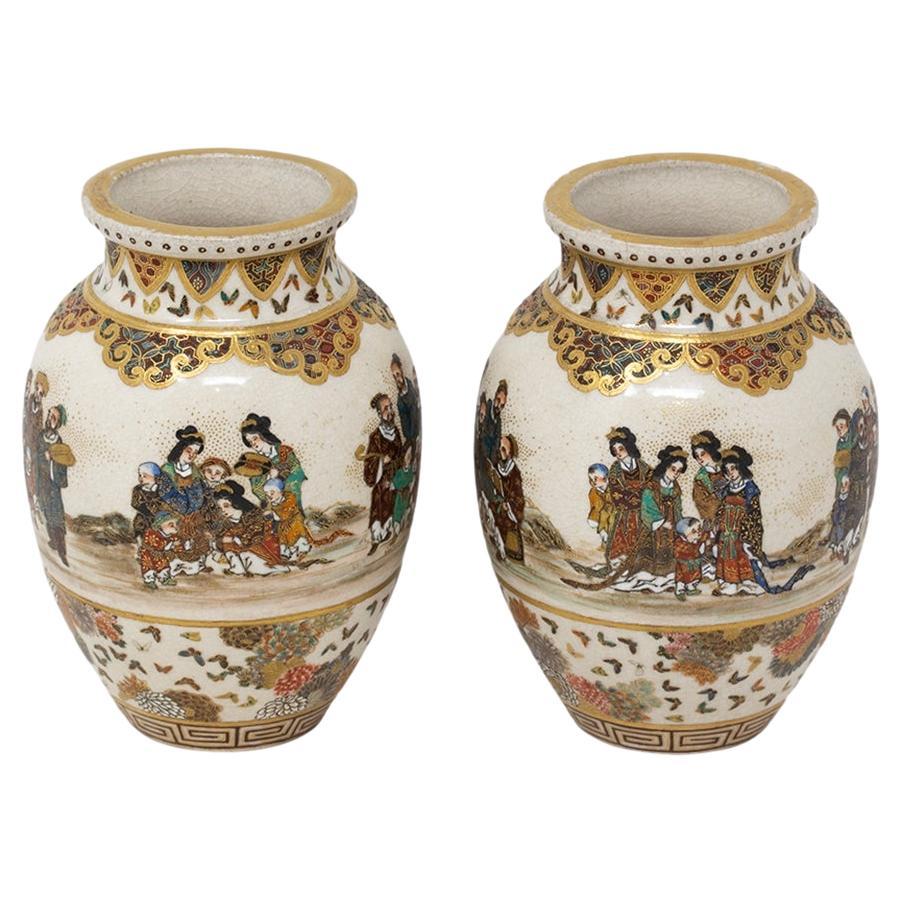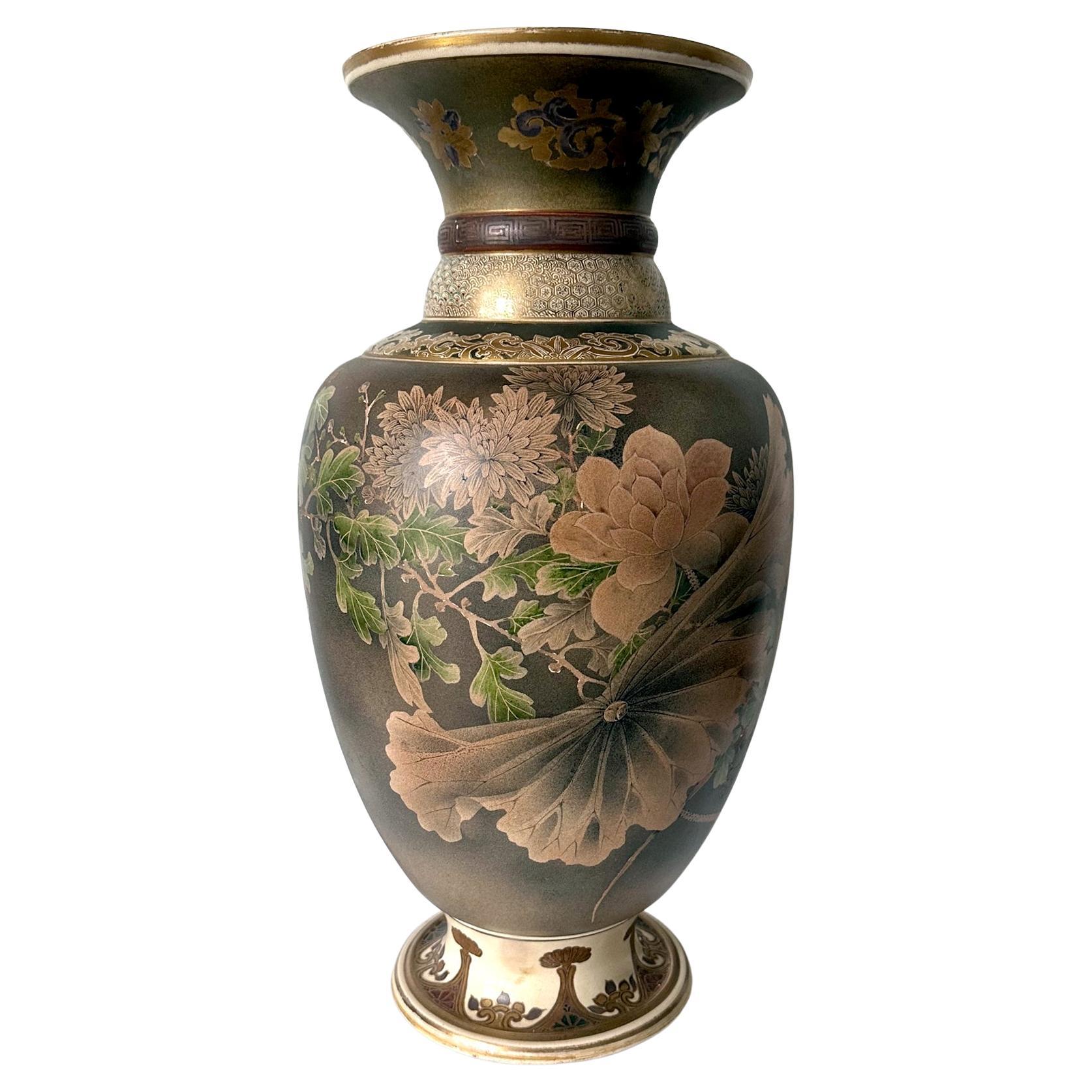Items Similar to Meiji Period Satsuma, Japanese Art Nouveau, Kinkōzan Decorative Bowl, ca. 1900
Want more images or videos?
Request additional images or videos from the seller
1 of 10
Meiji Period Satsuma, Japanese Art Nouveau, Kinkōzan Decorative Bowl, ca. 1900
About the Item
Dimensions Height: 2.5 inches Diameter: 12.25 inches
About the object
This unique decorative bowl, most likely, was created at the Kinkozan workshop. Kinkozan pottery enterprise was active in the period from 1645 to 1927. Headed by Kinkozan Sobei, it exported heavily from 1875, especially to America; and was considered the largest overall producer of Satsuma export ware.
About Meiji Period
The Meiji period (????, Meiji-jidai), also known as the Meiji Era, is a Japanese era which extended from September 8, 1868 through July 30, 1912.
About Satsuma Pottery
Satsuma ware (???, Satsuma-yaki) is a type of Japanese pottery originally from Satsuma Province, southern Kyushu. Today, it can be divided into two distinct categories: the original plain dark clay early Satsuma (???, Ko-Satsuma) made in Satsuma from around 1600, and the elaborately decorated export Satsuma (???, Kyo-Satsuma) ivory-bodied pieces which began to be produced in the nineteenth century in various Japanese cities. By adapting their gilded polychromatic enamel overglaze designs to appeal to the tastes of western consumers, manufacturers of the latter made Satsuma ware one of the most recognized and profitable export products of the Meiji period.
The precise origins and early innovations of Satsuma ware are somewhat obscure; however, most scholars date its appearance to the late sixteenth or early seventeenth century. The Satsuma region was ripe for the development of kilns due to its access to local clay and proximity to the Korean peninsula. In 1597–1598, at the conclusion of Toyotomi Hideyoshi’s incursions into Korea, Korean potters were forcefully brought to Japan to kick-start Kyushu's non-existent ceramic industry. These potters eventually mainly settled in Naeshirogawa and Tateno, which were to become the hub of the local pottery industry.
Satsuma ware dating up to the first years of the Genroku era (1688–1704) is often referred to as Early Satsuma or ko-satsuma. The oldest remaining examples of Satsuma are stoneware made from iron-rich dark clay covered in dark glaze. Prior to 1790, pieces were not ornately decorated, but rather humble articles of folk-ware intended for practical everyday use in largely rustic environments or the tea ceremony. Given that they were "largely destined for use in gloomy farmhouse kitchens", potters often relied on tactile techniques such as raised relief, stamp impressions and clay carving to give pieces interest.
The intense popularity of Satsuma ware outside Japan in the late nineteenth century resulted in an increase in production coupled with a decrease in quality. Collectors sought older, more refined pieces of what they erroneously referred to as early Satsuma. These were in fact simply better-quality pre-Meiji nineteenth-century pieces, works from other potteries such as Kyoto's Awata ware (???, Awata-yaki), or counterfeits.
From around 1800, brocade (??, nishikide) painted decoration began to flourish, including a palette of "delicate iron-red, a glossy blue, a bluish green, a soft purple black, and a yellow very sparingly used". A slightly later innovation added painted gilding to the brocade (???, kin nishikide). The multi-colored enamel overglaze and gold were painted on delicate, ivory-bodied pieces with a finely crackled transparent glaze. The designs—often light, simple floral patterns—were highly influenced by both Kyoto pottery and the Kano school of painting, resulting in an emphasis on negative space. Many believe this came from Satsuma potters visiting Kyoto in the late seventeenth century to learn overglaze painting techniques.
The first major presentation of Japanese arts and culture to the West was at Paris' Exposition Universelle in 1867, and Satsuma ware figured prominently among the items displayed. The region's governor, the daimyo, understood early the economic, prestige and political advantages of a trade relationship with the West. In order to maintain its connection with Satsuma, for example, Britain offered support to the Daimyo in the 1868 rebellion against the shogunate. The Paris Exposition showcased Satsuma's ceramics, lacquerware, wood, tea ceremony implements, bamboo wicker and textiles under Satsuma's regional banner—rather than Japan's—as a sign of the Daimyo's antipathy to the national shogunate.
Following the popularity of Satsuma ware at the 1867 exhibition and its mention in Audsley and Bowes’ Keramic Art of Japan in 1875, the two major workshops producing these pieces, those headed by Boku Seikan and Chin Jukan, were joined by a number of others across Japan. "Satsuma" ceased to be a geographical marker and began to convey an aesthetic. By 1873, etsuke (???) workshops specializing in painting blank-glazed stoneware items from Satsuma had sprung up in Kobe and Yokohama. In places such as Kutani, Kyoto and Tokyo, workshops made their own blanks, eliminating any actual connection with Satsuma. From the early 1890s through the early 1920s there were more than twenty netsuke factories producing Satsuma ware, as well as a number of small, independent studios producing high-quality pieces.
Eager to tap into the burgeoning foreign market, producers adapted the nishikide Satsuma model. The resulting export style demonstrated an aesthetic thought to reflect foreign tastes. Items were covered with the millefleur-like 'flowerpacked' (??, hanazume) pattern or 'filled-in painting' (?????, nuritsubushi) to the point of horror vacui. They were typically decorated with "'quaint' ... symbols such as pagodas, folding fans, or kimono-clad [females]". Pieces continued to feature floral and bird designs, but religious, mythological, landscape and genre scenes also increased. There was new interest in producing decorative pieces (okimono), such as figurines of beautiful women (bijin), animals, children and religious subjects. The palette darkened, and there was generous application of moriage (????) raised gold.
The mid-1880s saw the beginning of an export slump for many Japanese goods, including Satsuma ware, linked in part to a depreciation of quality and novelty through mass production. By the 1890s, contemporary Satsuma ware had become generally denigrated by critics and collectors. It was negatively received at Chicago's Columbian Exposition of 1893, but remained a popular export commodity into the twentieth century, becoming "virtually synonymous with Japanese ceramics" throughout the Meiji period. Satsuma ware continued to be mass-produced through the modern period, though quality declined to the point where it eventually lost interest for consumers.
- Dimensions:Height: 2.5 in (6.35 cm)Diameter: 12.25 in (31.12 cm)
- Style:Meiji (Of the Period)
- Materials and Techniques:
- Place of Origin:
- Period:1900-1909
- Date of Manufacture:circa 1900
- Condition:Wear consistent with age and use. We make our best effort to provide a fair and descriptive condition report. Please examine photos attentively, as they are an integral part of the description. Send us a message to request more details or discuss price.
- Seller Location:New York, NY
- Reference Number:1stDibs: LU2819330254472
About the Seller
5.0
Vetted Seller
These experienced sellers undergo a comprehensive evaluation by our team of in-house experts.
Established in 1993
1stDibs seller since 2017
68 sales on 1stDibs
Typical response time: 2 hours
- ShippingRetrieving quote...Ships From: New York, NY
- Return PolicyA return for this item may be initiated within 10 days of delivery.
More From This SellerView All
- Japanese Kyoto Fuzan Satsuma Ware Double-Handled Vase, Meiji Period, ca. 1900Located in New York, NYThis beautiful end of Meiji Period Japanese Kyoto Fuzan Satsuma Ware double-handled vase has a gold plated intricate infinite circular relief pattern design and two images of goddess...Category
Antique Early 1900s Japanese Taisho Vases
MaterialsPorcelain
- Japanese Art Nouveau Meiji Period Patinated Bronze Vase, circa 1900Located in New York, NYAlthough unmarked, this rare and important, grand but at the same exquisite patinated bronze vase has just a very few little details, defying the shape of the handles, as well as the...Category
Antique Early 1900s Japanese Art Nouveau Vases
MaterialsBronze
- Japanese Meiji Era Bronze Lotus Leaf Bowl, Vide Poche, ca. 1900Located in New York, NYDIMENSIONS: Height: 4 inches Width: 6 inches Depth: 6 inches ABOUT THE OBJECT With the laconic Japanese-style Art Nouveau design, filled with symbolism and metaphorism, this multi-use bowl...Category
Antique Early 1900s Japanese Art Nouveau Vases
MaterialsBronze
- Japanese Art Nouveau Awaji Ware Art Studio Pottery Flower Vase, ca. 1900sLocated in New York, NYJapanese Art Nouveau Flower Vase Awaji Ware Art Studio Pottery ca. 1900s ABOUT AWAJI WARE ART STUDIO POTTERY Awaji pottery was made on the Japanese island of the same name between...Category
Antique Early 1900s Japanese Art Nouveau Vases
MaterialsPottery
- Japanese Art Nouveau, Awaji Ware Art Studio Pottery Flower Vase, Ca. 1900By Awaji PotteryLocated in New York, NYDIMENSIONS: Height: 12.5 inches Width: 6.75 inches Depth: 6.75 inches ABOUT AWAJI POTTERY Awaji pottery was made on the Japanese island of the same name between 1830 and 19...Category
Antique Early 1900s Japanese Art Nouveau Vases
MaterialsCeramic
- Pair of Japanese Patinated Bronze Candelabras, Meiji Period, ca. 1900Located in New York, NYThis most unusual pair of original 18th century Japanese patinated bronze candelabras, uniquely designed as branches of mountain flowers entangled by a dragon, are mounted on the con...Category
Antique Late 19th Century Japanese Japonisme Candelabras
MaterialsBronze
You May Also Like
- Satsuma Earthenware Vase, by Kinkozan, Japanese, Meiji PeriodBy SatsumaLocated in West Palm Beach, FLA Satsuma Earthenware Vase, by Kinkozan, Japanese, Meiji period (1868-1912) decorated in polychrome enamels and gilt over a clear, crackled glaze, delicately painted with ladies and men, the reverse with a flowering garden with sprays of flowers, the neck with geometric and floral designs, a band of kifu heads in silver and gilt above the foot, on a midnight-blue ground, signed Kinkozan zo...Category
Antique 1860s Vases
MaterialsEarthenware
- A Pair Satsuma earthenware vases by Kinkozan, Meiji periodBy KinkozanLocated in West Palm Beach, FLA Pair Satsuma earthenware vases by Kinkozan, Meiji period of square section, decorated with birds and flowers alternating with figures, all reserved on a midnight-blue ground with floral designs, each signed Kinkozan zo...Category
20th Century Vases
MaterialsCeramic
- Japanese Meiji Period Satsuma Floor VasesLocated in Newark, EnglandThe vases of large oval form potted from earthenware with pinched neck and base stood upon a splayed circular foot. The vases extensively decorated with a continuous scene with polychrome colours and raised enamels featuring a large central white elephant and various figures. The top and bottom bordered by arched gilt decoration and gilded rims. The bases signed by a three character mark in red 新井造 Arai Zo (made by Arai). The vases date to the Meiji period (1868-1912) and are large in size measuring 46cm High. Meiji Period is an era of Japanese history that spanned from 1868 to 1912. It was the first half of the Empire of Japan, when the Japanese people began to build a paradigm of a modern, industrialised nation state and emergent great power, influenced by Western countries and aesthetics. As a result of radically different ideas, the changes to Japan were profound and it affected the social structure, politics, economy, military, and foreign relations...Category
Antique Late 19th Century Japanese Meiji Vases
MaterialsCeramic, Earthenware
- Japanese Meiji Period Satsuma Vase Pair GyokuzanLocated in Newark, EnglandPainted with Continuous Scenes From our Japanese collection, we are delighted to offer this Japanese Satsuma Vase Pair by Gyokuzan. The vases of squat bulbous form with pinched neck...Category
Antique Late 19th Century Japanese Meiji Vases
MaterialsCeramic, Pottery, Earthenware
- Large Japanese Satsuma Ceramic Vase KinkozanBy KinkozanLocated in Atlanta, GAA large Japanese ceramic vase from the end of Meiji period circa 1890-1910s by Kinkozan (1645-1927). One of the largest studio manufacturers of the export ceramics at the time based in Kyoto. In the typical style of satsuma made at the turn of 20th century, the vase is elaborately decorated with a rather unusual kinran-de (gold paint) and green enamel highlight on a mottled brown background. The painterly decoration depicts a large seasonal floral arrangement in a circular fashion. Besides the obviously superb craftsmanship, what sets this particular vase apart from many lower quality and mass-produced pieces is its tone-on-tone color pallet that is visually somber and the small and sensitive details that heralds the change of the seasons. When the viewer goes beyond the first casual glimpse of the blossom and foliage, one would notice that on the edges of certain leaves as well as along the stalks, there accumulates a very thin layer of the white dust that represents the frost. The flower in bloom are chrysanthemums. Despite of being splendid, they are the messengers of the autumn. The large lotus leaf was subtly rendered in a bended and slightly withered manner, just past its prime. Although the lotus is still in bloom, the prominent seed pod indicates it may be the last for the season. The sentimental capture of the change of the seasons is not unusual in Japanese art. This vase poetically represents such a subtle transition from summer to fall, perhaps depicting the very first frost. The neck of the vase is also slightly unusual with two rolled rings...Category
Early 20th Century Japanese Meiji Ceramics
MaterialsCeramic
- Fine Japanese Ceramic Satsuma Vase by KinkozanBy KinkozanLocated in Atlanta, GAA miniature Japanese ceramic vase from the end of Meiji period circa 1880s- 1910s by Kinkozan (1645-1927). One of the largest studio manufacturers of the export ceramics at the time ...Category
Early 20th Century Japanese Meiji Ceramics
MaterialsCeramic
Recently Viewed
View AllMore Ways To Browse
Red Pagoda
Pagoda Red
Pagoda Red Furniture
Southern New And Used Furniture
Local Pottery
1920s Modern Period Furniture
Japanese Old Pottery
Japanese Studio Vase
Japanese Wood Vase
Japanese Clay Vessel
Small Japan Vase
Mid Century Japan Vessel
Japanese Old Vessel
Antique Clay Vessel
Ivory Japan
Japanese Ivory
Small Japanese Vases
Korean Japanese
